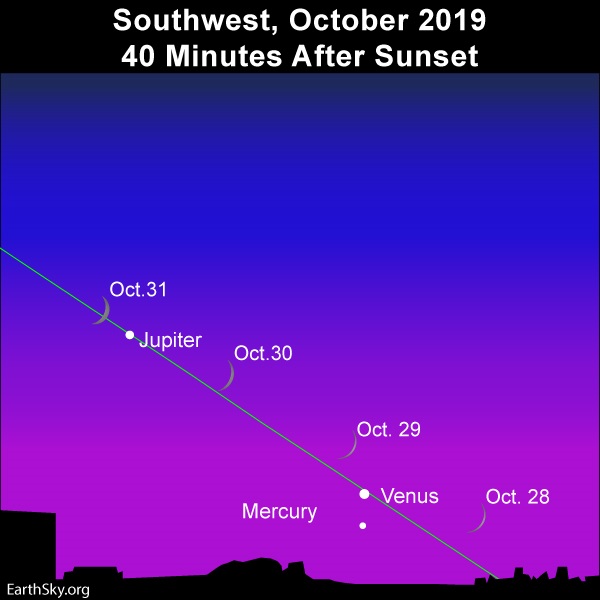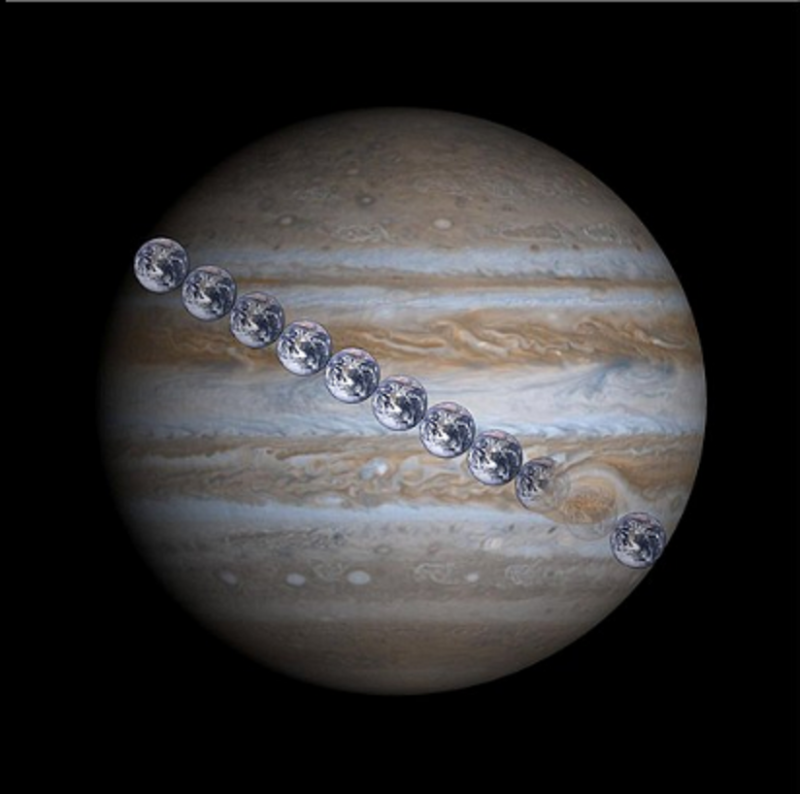
On October 30 and 31, 2019, watch for two brilliant luminaries – the crescent moon and the dazzling planet Jupiter – to pop out in close vicinity of one another as dusk deepens into nightfall. Given clear skies, you should have no trouble seeing either world, because the moon and Jupiter rank as the 2nd-brightest and 4th-brightest celestial luminaries, respectively. By early November, a larger crescent moon will leave king planet Jupiter behind to join up with the ringed planet Saturn.
The planet Venus beams as the 3rd-brightest celestial object (after the sun and moon) but you have to catch Venus quite soon after sunset. At northerly latitudes, Venus follows the sun beneath the horizon before nightfall, and at temperate latitudes in the Southern Hemisphere, Venus stays out till after nightfall.
Click here to find an sky almanac providing you with the setting times for the sun, moon and planets in your sky.

Have you been watching the young moon lately? The last few days – on October 28 and 29 – it was quite close to the planets Venus and Mercury on the sky’s dome.
These next few nights, as darkness falls, simply look for the brilliant “star” by the moon and that’ll be Jupiter, the 5th planet from the sun, and the solar system’s largest planet. The gas giant Jupiter has the volume of 1,321 Earth’s!
The moon, planets and stars will all move westward as evening deepens into late night. But all these celestial objects move westward across the sky for the same reason that the sun moves westward during the day. This supposed motion is really a reflection of the Earth spinning on its rotational axis from west-to-east – making it appear as though the sun, stars, moon and planets all travel westward around the Earth each day.

Eleven Earths lined up side by side equal the diameter of the king planet Jupiter. Image via Wikimedia Commons.
All the while, however, the moon is moving eastward relative the stars and planets of the zodiac. The moon travels about 1/2 degree (its own angular diameter) eastward per hour or about 13 degrees eastward per day. Day by day, at the same time, note the moon’s change of position relative to the backdrop stars and planets. This moon’s change of position is due to the moon’s orbital motion.
Starting in late October 2019, watch for the waxing crescent moon to go past Jupiter as it heads toward the planet Saturn, the sixth planet from the sun and the second-largest planet in the solar system.
from EarthSky https://ift.tt/2JzQyBb

On October 30 and 31, 2019, watch for two brilliant luminaries – the crescent moon and the dazzling planet Jupiter – to pop out in close vicinity of one another as dusk deepens into nightfall. Given clear skies, you should have no trouble seeing either world, because the moon and Jupiter rank as the 2nd-brightest and 4th-brightest celestial luminaries, respectively. By early November, a larger crescent moon will leave king planet Jupiter behind to join up with the ringed planet Saturn.
The planet Venus beams as the 3rd-brightest celestial object (after the sun and moon) but you have to catch Venus quite soon after sunset. At northerly latitudes, Venus follows the sun beneath the horizon before nightfall, and at temperate latitudes in the Southern Hemisphere, Venus stays out till after nightfall.
Click here to find an sky almanac providing you with the setting times for the sun, moon and planets in your sky.

Have you been watching the young moon lately? The last few days – on October 28 and 29 – it was quite close to the planets Venus and Mercury on the sky’s dome.
These next few nights, as darkness falls, simply look for the brilliant “star” by the moon and that’ll be Jupiter, the 5th planet from the sun, and the solar system’s largest planet. The gas giant Jupiter has the volume of 1,321 Earth’s!
The moon, planets and stars will all move westward as evening deepens into late night. But all these celestial objects move westward across the sky for the same reason that the sun moves westward during the day. This supposed motion is really a reflection of the Earth spinning on its rotational axis from west-to-east – making it appear as though the sun, stars, moon and planets all travel westward around the Earth each day.

Eleven Earths lined up side by side equal the diameter of the king planet Jupiter. Image via Wikimedia Commons.
All the while, however, the moon is moving eastward relative the stars and planets of the zodiac. The moon travels about 1/2 degree (its own angular diameter) eastward per hour or about 13 degrees eastward per day. Day by day, at the same time, note the moon’s change of position relative to the backdrop stars and planets. This moon’s change of position is due to the moon’s orbital motion.
Starting in late October 2019, watch for the waxing crescent moon to go past Jupiter as it heads toward the planet Saturn, the sixth planet from the sun and the second-largest planet in the solar system.
from EarthSky https://ift.tt/2JzQyBb

Aucun commentaire:
Enregistrer un commentaire